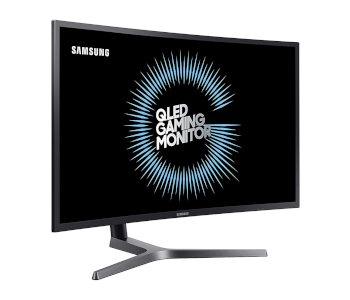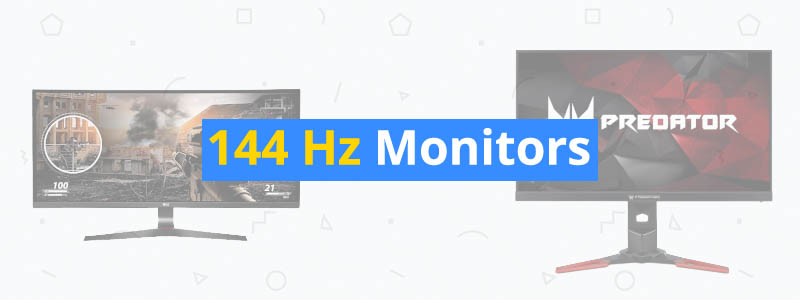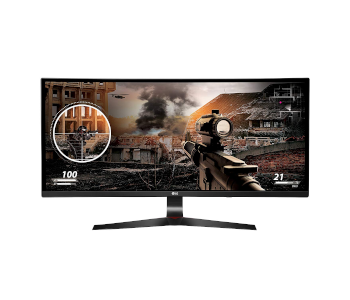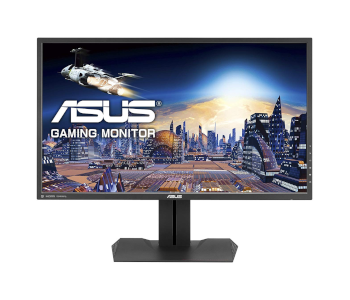5 Best 144 Hz Monitors
If you want a 144 Hz monitor strictly for competitive gaming and not much else, consider the best cheap 144 Hz monitors. If, however, you want a more all-around 144 Hz monitor for both gaming and general use, there are better options on the market – but they don’t come cheap, with the best ones selling for well over $500.
With this guide, we’ll make shopping for the best 144 Hz monitors easier for you. In this guide, we have compiled the best products that offer excellent value. Although all the monitors included here are marketed for gaming use, they also work well for office work and general use.
| Budget |
|---|
 |
| ViewSonic XG2402 |
| 3.9/5.0 |
| Size: 24 in |
| Resolution: 1920 x 1080 |
| Very low input lag and excellent response time. |
| Check Amazon |
| Best Value |
|---|
 |
| Samsung C27HG70 |
| 4.4/5.0 |
| Size: 27 in |
| Resolution: 2560 x 1440 |
| High native contrast ratio and fast response time. |
| Check Amazon |
| Top Pick |
|---|
 |
| Acer Predator XB271HU |
| 4.5/5.0 |
| Size: 27 in |
| Resolution: 2560 x 1440 |
| Great picture quality and has Nvidia G-Sync support. |
| Check Amazon |
144 Hz Monitors Comparison Table
| Make and Model | Rating | Size | Resolution | Refresh Rate | Response Time | Panel Type | Weight | Price |
|---|---|---|---|---|---|---|---|---|
| Acer Predator XB271HU | 4.5 | 27 in | 2560 x 1440 | 144 Hz | 4 ms | IPS | 17.6 lb | Check Price |
| ViewSonic XG2402 | 3.9 | 24 in | 1920 x 1080 | 144 Hz | 1 ms | TN | 14.8 lb | Check Price |
| Samsung C27HG70 | 4.4 | 27 in | 2560 x 1440 | 144 Hz | 1 ms | VA | 13.9 lb | Check Price |
| LG 34UC79G-B | 4.2 | 34 in | 2560 x 1080 | 144 Hz | 5 ms | IPS | 18.7 lb | Check Price |
| Asus MG279Q | 4.1 | 27 in | 2560 x 1440 | 144 Hz | 4 ms | IPS | 16.1 lb | Check Price |
1. Best Pick: Acer Predator XB271HU
Editor’s Rating: 4.5/5
If you want the best all-around 144 Hz monitor for both gaming and general use, the two products that should be at the top of your list are the Acer Predator XB271HU and the Asus ROG Swift PG279Q. Of the two, the latter is the better machine overall, but only by a slim margin. On the other hand, the former is more affordable, selling for around $100-150 less.
You can’t go wrong with either product – both are excellent options. We went with the cheaper option here because it offers a similar performance for a much lower price. You can get it for around $650, though if you catch it on a big sale, you might be able to get your hands on it for about $500, which is a total steal.
A 27-inch IPS monitor, the XB271HU has a more understated design compared to Asus’ offering, featuring a thin bezel and a sturdy stand with red accents. The stand offers full adjustability, with options to adjust the height, tilt, swivel, and rotate to portrait mode. A small hole on the stand keeps cables organized. And as for the back panel, Acer kept it simple, opting for a clean design instead of going for eye-catching aesthetics.
Most of the connection ports are positioned downward on the back panel, with the only exception being the two side-facing USB ports on the left edge. The down-facing ports include one HDMI port, one DisplayPort, an audio out, and two more USB ports. The input ports are easy enough to access, even when the monitor is wall-mounted. If you are having trouble seeing them when switching cables, simply rotate the screen to portrait mode.
You’ll find the on-screen display buttons on the bottom-right corner. They are easy to use and don’t feel cheaply done, producing a satisfying click when pressed. Acer also did a good job with the on-screen display, equipping the monitor with a well-organized and easy-to-understand control panel with a good selection of options.
The XB271HU is an excellent all-around monitor for gaming. It’s got an exceptional response time, a very low input lag, and Nvidia G-Sync support. It’s great for different kinds of games, including first-person shooters, racing games, and action RPGs. The monitor has wide viewing angles and decent reflection handling. On the other hand, it has a low native contrast ratio and is not a good monitor for gaming in a dark room.
This gaming monitor is also great for productivity and general use. You can use it for media consumption, coding, internet surfing, graphics design, and regular office work. It has good color accuracy – but not out of the box. Unlike the PG279Q, it suffers from mediocre color accuracy in its default form, so you’ll have to spend some time calibrating it. Once properly calibrated, the colors will be much better, with great coverage for the sRGB color space.
Overall, the XB271HU is a superb monitor that offers good long-term value. It’s good for all-around use, boasting great picture quality, a fast response time, very low input lag, good viewing angles, and multiple USB ports. It’s got built-in speakers as well, but don’t expect too much regarding sound quality. If you want one of the best 144 Hz monitors currently out on the market but don’t want to spend close to $1,000 on one, get this Acer monitor.
| Tech Specs |
|---|
| Size: 27 in |
| Resolution: 2560 x 1440 |
| Refresh Rate: 144 Hz |
| Response Time: 4 ms |
| Panel: IPS |
| Weight: 17.6 lb |
| The Pros |
|---|
| Great picture quality |
| Nvidia G-Sync support |
| Fast response time |
| Low input lag |
| Fully adjustable stand |
| Good viewing angles |
| The Cons |
|---|
| Poor color accuracy out of the box |
| Low native contrast ratio |
2. Best Budget: ViewSonic XG2402
Editor’s Rating: 3.9/5
Often considered the best 1080p TN monitor, the ViewSonic XG2402 is an excellent option if you can’t afford to spend over $300 for a 144 Hz display. Although it’s built specifically for pure gaming, it also works well for general use, boasting a picture quality that’s better than most other TN monitors in the same price range. You can get it for less than $250, which makes it significantly more affordable than all the other monitors listed here.
The XG2402 is a 24-inch gaming monitor with a good build quality, featuring a fairly thick bezel and a well-built stand with full adjustability. The stand, which has a headphones hook at the top, offers tilt, swivel, pivot, and height adjustment options. The XG2402 features a cool lighting system, with the red chevrons on the back panel lighting up.
Connection options include two HDMI ports, one DisplayPort, an audio out, and two USB 3.0 ports, all of which are positioned downward at the rear. This monitor also comes with built-in speakers, which are acceptable enough for low-volume music while doing office work or internet surfing. But for watching movies and gaming, it’s best to use headphones or external speakers.
Like our top pick, the XG2402 has a set of buttons on the bottom-right corner for controlling the on-screen menu. The control buttons are comfortable to use and give off a nice click when pressed. On the other hand, the on-screen menu itself is not well designed and can be confusing to navigate, but at least it has a lot of options to choose from.
While decent enough for office work and general use, the XG2402 is best used for gaming. Or more specifically, competitive gaming. It has an extremely fast response time and a very low input lag, which makes it a great monitor for first-person shooters and fighting games. It’s an outstanding monitor when it comes to motion handling, with very little motion blur. It offers AMD FreeSync support as well, with a range of 48-144 Hz, which is one of the better ranges out there.
As mentioned earlier, the XG2402 has better picture quality than most other TN monitors in the same price range, with great coverage for the sRGB color space and an acceptable rating for the Adobe RGB color space – and unlike our top pick, it has good color accuracy out of the box. It has a decent brightness rating and good reflection handling, but on the flip side, it has a poor contrast ratio. In addition, it has narrow viewing angles, as expected from a TN monitor.
If you can only spend around $250 for a 144 Hz monitor, the XG2402 is the best product on the market, with all the other options not really worth considering, especially if you want a monitor that works well for both gaming and general use. It has decent picture quality, good ergonomics, and exceptional response time and input lag.
| Tech Specs |
|---|
| Size: 24 in |
| Resolution: 1920 x 1080 |
| Refresh Rate: 144 Hz |
| Response Time: 1 ms |
| Panel: TN |
| Weight: 14.8 lb |
| The Pros |
|---|
| Good color accuracy |
| AMD FreeSync support |
| Very low input lag |
| Excellent response time |
| Fully adjustable stand |
| The Cons |
|---|
| Narrow viewing angles |
| Poor contrast ratio |
3. Best Value: Samsung C27HG70
Editor’s Rating: 4.4/5
Of the products in this guide, the Samsung C27HG70 easily stands out, mainly because of its unique design. It’s a curved gaming monitor equipped with a VA panel, offering good picture quality and excellent gaming performance. You can also use it for non-gaming activities, with its 27-inch screen and high resolution making it a good monitor for multitasking. You can get it for less than $500, with the 32-inch model selling for a bit more.
Compared to our other top picks, this Samsung monitor has a more eye-catching design, featuring an arm-like stand that’s bent in the middle, which translates to a different height adjustment system. It has a large overall footprint, mostly due to the stand, so make sure your desk can comfortably accommodate it. Without the stand, the unit is fairly thin for a curved monitor and will look good when mounted on the wall.
The stand is well built and has no trouble supporting the monitor, regardless of the height or screen orientation (portrait or landscape). You can adjust the height as well as tilt and swivel the screen, although the swivel range is not that generous. Like our budget pick, the C27HG70 has a cool lighting system on the back panel, with the ring around the stand mount lighting up.
In terms of input options, the C27HG70 is good. It has two HDMI ports and one DisplayPort, all of which are down-facing at the rear. You will also find an audio out, a mic in, and a pair of USB 3.0 ports on the connection dock; one of the USB 3.0 ports offers fast charging. Samsung didn’t include built-in speakers on this monitor, which might disappoint some of you, considering the price.
Like many LG monitors, the C27HG70 has a joystick-based control scheme, which is more intuitive than the usual buttons-based control scheme found in other monitors. The joystick is located on the bottom-right corner, on the backside, and is easy to use. Samsung also did a good job with the OSD, with the C27HG70 featuring a control panel that’s well organized and easy to navigate.
A recommended monitor for console gaming, the C27HG70 has AMD FreeSync support, excellent response time, and very low input lag across different resolutions. It has good picture quality, featuring excellent contrast, great coverage for the sRGB color space, and HDR support. On the other hand, it has narrow viewing angles, but it’s not as bad as cheap TN monitors. For non-gaming use, the C27HG70 is also a good monitor. It’s great for media consumption and is decent enough for office work, though you’ll have to get used to the limited viewing angles.
In some areas, the C27HG70 is even better than the Acer Predator XB271HU. Here’s a quick rundown of what separates them from each other: The C27HG70 is a VA monitor with a better contrast ratio, better color accuracy out of the box, and a higher max brightness. On the other hand, the XB271HU is an IPS monitor with better viewing angles, better ergonomics, and a smaller footprint.
Concerning gaming stats, the two monitors are very similar, with the most notable difference being their approach to variable refresh rate tech. Our top pick is on the green team (G-Sync) while this Samsung monitor is on the red team (FreeSync). If you like both monitors and are having a tough time deciding which is better for your gaming needs, then just go for whichever is a match for your graphics card, assuming you plan to use variable refresh rate tech.
In all, the C27HG70 is an excellent monitor, most especially for gaming use. It’s got a very high contrast ratio, a fast response time, low input lag, and good picture quality overall. Sadly, its curved screen doesn’t really add much. If you want a monitor that uses its curved screen more effectively, check out the next item on this list.
| Tech Specs |
|---|
| Size: 27 in |
| Resolution: 2560 x 1440 |
| Refresh Rate: 144 Hz |
| Response Time: 1 ms |
| Panel: VA |
| Weight: 13.9 lb |
| The Pros |
|---|
| Good picture quality |
| HDR support |
| High native contrast ratio |
| Fast response time |
| Low input lag |
| AMD FreeSync support |
| The Cons |
|---|
| Narrow viewing angles |
| Takes up a lot of desk space |
4. LG 34UC79G-B
Editor’s Rating: 4.2/5
If you want a curved monitor that’s more suitable for productivity, the LG 34UC79G-B is a better option than the Samsung C27HG70. It’s a 34-inch ultrawide monitor with a softer (less aggressive) curve radius of 3800R. It’s one of the most affordable curved ultrawide displays on the market, selling for around $500.
Unlike Samsung’s curved monitor, this LG monitor has an IPS panel, which means it has better viewing angles. It has an appealing design, featuring a thin bezel and a sturdy stand with red accents. It doesn’t have integrated speakers, which isn’t a big deal, considering monitor speakers are not that great in the first place. The 34UC79G-B is well built overall, with the stand easily supporting the 34-inch screen, with no serious wobbling issues.
However, the stand has limited adjustability. You can adjust the height and tilt the screen forward and backward, and that’s it. The stand has a protruding hole on the neck for cable management. If you want to save desk space, you can mount the monitor on the wall. It looks great in that setup and doesn’t stick out too much.
Like most other LG monitors, the 34UC79G-B has a small joystick at the bottom of the frame for controlling the OSD. While not easy to get used to at first, this control scheme is better than the usual buttons seen in most monitors and makes for a faster menu navigation. The OSD is also well designed, with a good selection of options.
All ports are outward-facing on the back panel, which makes them easy to access even when the monitor is sitting close to the wall. Connection options include two HDMI ports, one DisplayPort, and two USB 3.0 ports. In addition, the 34UC79G-B has a pair of audio out ports, with one port offering direct volume control; the other has a fixed volume.
The 34UC79G-B is a great monitor for productivity, with its ultrawide screen making multitasking easy and more fun. It has wide viewing angles, good color accuracy, and decent brightness, but as with other IPS displays, the contrast ratio is not good. The 34UC79G-B is suitable for office work but it’s not a recommended monitor for art-related work because of its low resolution and pixel density, considering its screen size.
Like all other products in this guide to the best 144 Hz monitors, the 34UC79G-B is an excellent display for gaming. It has a fast response time, a low input lag, and supports AMD FreeSync, with a decent FreeSync range of 50-144 Hz via DisplayPort. Its 2560 x 1080 resolution means your graphics card will have a relatively easier time maintaining a stable performance. But on the other hand, some gamers will definitely not like its low pixel density.
Overall, the 34UC79G-B is a solid option if you want an ultrawide monitor with a high native refresh rate. It has good picture quality, a fast response time, and wide viewing angles, and it’s great for both gaming and productivity. If you want a curved display with a higher resolution for productivity, check out some of our picks in our guide to the best curved ultrawide monitors.
| Tech Specs |
|---|
| Size: 34 in |
| Resolution: 2560 x 1080 |
| Refresh Rate: 144 Hz |
| Response Time: 5 ms |
| Panel: IPS |
| Weight: 18.7 lb |
| The Pros |
|---|
| Good color accuracy |
| AMD FreeSync support |
| Fast response time |
| Low input lag |
| Wide viewing angles |
| Great for multitasking |
| The Cons |
|---|
| Subpar contrast ratio |
| Low pixel density |
| Limited stand adjustability |
5. Asus MG279Q
Editor’s Rating: 4.1/5
The Asus MG279Q is a good alternative if you want something similar to our top pick but prefer to limit your expenses to around $500. It has similar specs, featuring a 27-inch screen, a 2560 x 1440 native resolution, and a fast response time. Like our top pick, it’s great for both gaming and general use, although its manufacturer advertises it as a gaming monitor. You can get it for about $500, which puts it in the same price range as the LG ultrawide monitor above.
Compared to Asus’ premium gaming monitors, the MG279Q has a simpler design, with Asus eschewing futuristic-looking aesthetics in favor of a more basic one. The monitor has a well-built frame with a narrow bezel and comes with a sturdy stand. Out of the box, adjusting the stand is easy, with options to adjust the height and tilt and swivel the screen.
Like the LG and Samsung displays above, this Asus monitor features a joystick control for navigating the on-screen display. Along with the clickable buttons, the small joystick is located on the bottom-right corner, on the backside, with labels on the front panel. Although it might take a bit of time for you to get used to it, the menu control system is more intuitive than the usual buttons-based menu control.
The MG279Q’s on-screen display is good and easy to navigate, offering a good selection of calibration options and gaming-specific features. Unlike our top pick, this Asus gaming monitor comes with decent color accuracy out of the box, so there’s no need to immediately tinker with the color settings. What you will want to adjust at the onset is the brightness, as the default setting is a bit too high.
Concerning connection options, the MG279Q is similar to all the other products listed here, offering both an HDMI and a DisplayPort, as well as a USB hub. In addition to that, it also features a Mini DisplayPort, which is fairly uncommon today, with the Dell professional monitors being the most notable ones that carry such a port. All connection ports are on the back panel, positioned downward, with reference markers etched below them.
The MG279Q is best used for gaming. It’s got a fast response time, great input lag across different resolutions, and AMD FreeSync support, with a FreeSync range of 35-90 Hz. It has good picture quality and boasts wide viewing angles, which is unsurprising considering it’s an IPS display. On the other hand, it has a mediocre contrast and is not good for gaming in a dark room. So avoid playing games with a lot of dark scenes – such as Resident Evil 7: Biohazard and The Evil Within – while in a very dark room, even though it makes for a more immersive experience.
If you want to use the MG279Q for office work and general use, feel free to do so, as the monitor is also great for non-gaming use. You can use this monitor for media consumption, coding, basic photo editing, and internet surfing, among other things. It has a high resolution, so texts are sharper and images are more detailed.
Although not as good as our top pick, the MG279Q is still one of the best 144 Hz monitors currently out on the market. It’s easy to set up and offers good picture quality, good viewing angles, a fast response time, and a fully adjustable stand. If our top pick is out of your budget range, take a look at this QHD monitor instead.
| Tech Specs |
|---|
| Size: 27 in |
| Resolution: 2560 x 1440 |
| Refresh Rate: 144 Hz |
| Response Time: 4 ms |
| Panel: IPS |
| Weight: 16.1 lb |
| The Pros |
|---|
| Good picture quality |
| AMD FreeSync support |
| Wide viewing angles |
| Fast response time |
| Low input lag |
| Intuitive joystick control |
| The Cons |
|---|
| Mediocre contrast ratio |
| Poor quality control |
Contents




